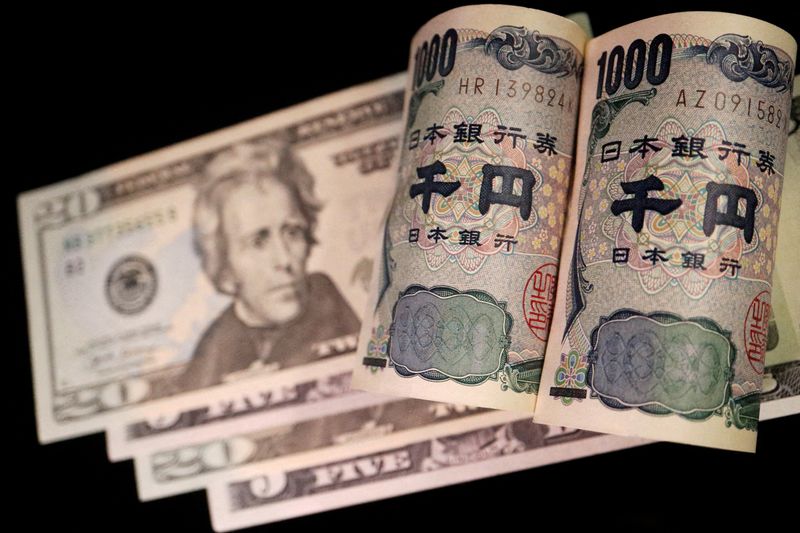By Karen Brettell
NEW YORK (Reuters) -The dollar reached a five-month high against the euro on Tuesday after Federal Reserve Chair Jerome Powell said the U.S. central bank may need to keep rates higher for longer as inflation remains sticky.
The greenback also hit its highest level against the Japanese yen since 1990, with traders on alert for possible intervention by Japanese authorities.
The greenback has been bolstered by stronger-than-expected growth data, including retail sales data for March released on Monday. Stickier-than-hoped inflation in particular is seen as making it less likely that the Federal Reserve will begin cutting interest rates in the coming months.
“The reality is that you have an expanding economy,” said Juan Perez, director of trading at Monex USA in Washington. “In Q4 the idea was that we were going to slow down here in the United States, but there is evidence of the contrary.”
Powell on Tuesday noted a “lack of further progress” this year toward the 2% inflation target.
“The recent data have clearly not given us greater confidence and instead indicate that it’s likely to take longer than expected to achieve that confidence,” Powell told a forum in Washington, in what is likely to be his last public appearance before the April 30-May 1 policy meeting.
Traders pushed back expectations on when the U.S. central bank is likely to begin cutting rates after consumer price pressures for March on Wednesday were above economists’ expectations.
Traders are currently pricing in fewer than two 25 basis point cuts this year, after previously expecting three. The first cut is now seen as most likely in September, after previously being expected as soon as June.
Escalating geopolitical tensions between Israel and Iran are also adding a safe-haven boost to the U.S. currency.
“We are very isolated from a lot of the problems in FX overseas, and now this weekend we’re finally seeing a major escalation. … It makes the dollar a safe haven unlike anything else,” Perez said.
Israel’s war cabinet had been set to meet for the third time in three days on Tuesday to decide on a response to Iran’s first-ever direct attack, amid international pressure to avoid further escalating the conflicts in the Middle East. But the meeting was put off until Wednesday, an Israeli government source said. The source did not elaborate.
{{2126|The do was last up 0.04% at 106.24, after earlier reaching 106.51, the highest since Nov. 1.
The euro gained 0.08% to $1.0631 after dropping as low as $1.06013 in the wake of Powell’s comments, the weakest since Nov. 2.
The dollar strengthened 0.23% to 154.62 Japanese yen and earlier reached a 34-year high of 154.79.
Traders are focused on whether Japanese monetary authorities will step in to shore up the currency as it rapidly deteriorates. Officials have ramped up warnings about a possible intervention, though analysts also note that it would be difficult, and expensive, to fight a strong bullish dollar trend.
Japanese Finance Minister Shunichi Suzuki said on Tuesday he was closely watching currency moves and will take a “thorough response as needed.”
“Intervention can only work today to slow or manage the pace of depreciation, but cannot turn a trend. And it’s actually very costly,” said Kenneth Broux, head of corporate research, FX and rates at Societe Generale (EPA:).
“The big challenge for a number of these Asian currencies, is that as long as U.S. bond yields keep grinding higher, you’re not going to get a lot of success because you’re fighting a wider yield spread.”
The dollar briefly saw a sharp drop against the Japanese currency on Tuesday, falling from around 154.76 to 153.90 in a few minutes, which raised some jitters around an intervention.
Analysts at Nomura led by Yujiro Goto said in a report that Japanese officials were unlikely to have been behind the move, adding that the incident reflects market nerves about them stepping in.
“It is likely reflecting the market is becoming more sensitive to sudden falls in , as the pair has approached the milestone level of 155,” the analysts said. “The move in itself may consequently slow the pace of the rise in USD/JPY, as the market becomes more aware and sensitive to potential FX intervention.”

The Australian dollar fell as low as $0.63895, its weakest since Nov. 14
In cryptocurrencies, bitcoin fell 0.31% to $62,873.63.










